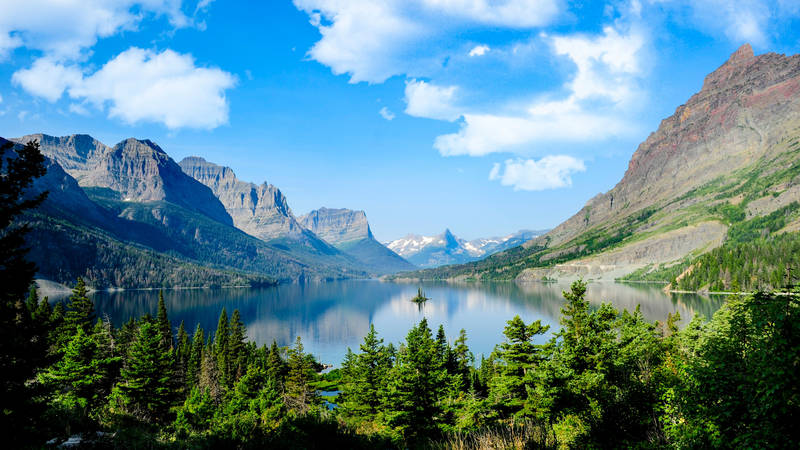Climate change is affecting more than just the glaciers: perspectives from a 50-year park veteran.
Glacier National Park is a place where visitors can see the effects climate change is having on the natural world. The park’s once-numerous glaciers are rapidly melting, and scientists expect them to disappear completely by 2030. But even the prominent and shocking loss of these namesake features, which has drawn widespread media attention and concern, only begins to capture the magnitude of the problem.
Climate change is also dramatically altering the landscape of the park, resulting in less water, more heat and intense fires, and big increases in problematic bug and plant species, according to one long-time observer. Jack Potter has been working and volunteering at this landmark destination for nearly five decades and has gained insight into the challenges Glacier is facing from climate change.
Potter started working as a busboy at a café in the Many Glacier region of the park when he was a young man in 1969 after moving west from Pennsylvania. He began work with the National Park Service the next year and never really left. When Potter retired 41 years later, he was the chief of science and resources management after wearing many different hats during his career and influencing plans to manage the park’s ecosystems. Potter has traversed Glacier many times over, gaining intimate familiarity with this wild American landscape. Retirement hasn’t stopped him — over the last seven years he has become a volunteer backcountry ranger for the Park Service, helping to ensure the safety of visitors and wildlife off the beaten paths of the park. He is also now an active member of the Coalition to Protect America’s National Parks, an advocacy group of experienced park retirees working to protect and preserve the parks and the mission and goals of the Park Service.
Potter’s familiarity with Glacier over such a long time span has given him up-close and rare perspectives on climate change. He notes, “The speed, severity and extent of climate-related change is incredible in my short 50-year observational period. … It’s happening too fast for many species to adapt and is changing the face of the park.“
The effects have been so pronounced at Glacier that visitors can see the changes with their own eyes — even on a first visit.
“The biggest things a visitor to Glacier might visibly notice that are directly related to climate change are the shrinking of glaciers and … perennial snowfields — both symptoms of hotter and drier conditions,” Potter explains, describing how streams in the park have become both smaller and warmer as a result of less snow and earlier snowmelt. Changes are also apparent in the park’s forests, with vast swaths that have been decimated by fires, diseases, droughts and insects. “In just driving along the Going to the Sun Road, you can see acres and acres of impaired forests,” he says. “It’s expansive.”
My own experiences last summer confirm this. I traveled to Glacier in August 2017 for a week-long Climate Hike to raise awareness and funds for groups such as NPCA working to address the climate crisis. When I arrived, it hadn’t rained in the park in well over a month. The first thing I noticed was the intense dry heat, which felt alarming and extreme. Everything seemed parched, like a tinderbox ready to go.
Sure enough, one week later, intense and extreme wildfires hit the park, destroying much of the cherished 104-year old Sperry Chalet and acres of old-growth forests — some that hadn’t burned in over 400 years. I witnessed with my own eyes the shrinking glaciers, the vast expanses of damaged and destroyed forests. Even as someone new to this area, I could tell things were out of balance.
Fires are typical in the West and play an important role in shaping the ecology, but climate change has altered the nature of these fires. Potter explains that forests have more fuel available because smaller, more sustainable fires aren’t the norm anymore, partly due to years of fire suppression. Plus, intense wind and heat combined with earlier springs and longer summers add up to longer, more severe and more intense fire seasons.

Willfully Ignoring Climate Change Is a Disaster for National Parks
Trump administration repeals climate-smart management policies for national parks.
See more ›“These hotter fires mean entire forest areas are replaced, soil structures and microorganisms are damaged, and these new, hot, dry microclimates inhibit forest regrowth,” says Potter. He notes that hot, dry conditions have made fires more common at higher elevations — something nearly unheard of in decades past. “What I‘ve seen as I’ve traveled around with my wife is that tree regeneration is absent in many areas … So, these high, old-growth forests burn and convert to shrub lands or grasslands, which alters the whole ecosystem.”
The rise of diseases and tree-ravaging insects also contributes to the mortality of the forests, which in turn increases the potential for wildfires to be larger, more severe and intense. “With warmer temperatures, and longer, drier summers, trees have become weakened by drought stress and are more susceptible to wildfire,” he explains.
Warmer winters mean more insect survival in addition to drought stress. “Large die-offs are occurring due to mountain pine beetles, spruce budworm and other bark beetles,” Potter notes. These parasites affect animals, too. Moose in particular suffer from rising tick populations, which are new to the area, having moved north on whitetail deer.
Jack Potter has spent a lifetime of service in this park, and his experiences are cause for deep concern. We need to act decisively to reduce human contribution to climate change, not just for the sake of Glacier National Park, but for all species and ecosystems, all around the globe.
Yet the Trump administration has been systematically rolling back regulations that take steps to address this serious problem. The Clean Power Plan, a common-sense rule for reducing climate pollution from coal-fired power plants, is one of the latest measures now on the chopping block.
“The shortsighted proposal to repeal the plan will have long-lasting impacts on people, parks and ecosystems,” Potter explains. “To not attempt to slow the accumulation of greenhouse gases, along with the rest of the world, is to exacerbate the known problems we pass along to future generations.”
Stay On Top of News
Our email newsletter shares the latest on parks.
Once fully implemented, the Clean Power Plan would reduce carbon dioxide pollution across the electric utility sector by 32 percent below 2005 levels by 2030. The United States is already most of the way toward this goal at 27 percent. There are other critical benefits, too — a recent study from Syracuse University found that a repeal of the plan could mean a 45 percent increase in the unhealthy sulfur dioxide pollution that forms haze in our parks. According to the same study, keeping the Clean Power Plan in place would prevent up to 3,600 premature deaths and 90,000 asthma attacks by 2030.
Whether you spend 50 years at Glacier like Jack Potter, or just a few days like me, the takeaway is clear: We can’t continue to gamble with our climate. Repealing rules that would rein in our biggest climate polluters is simply wrong. The Environmental Protection Agency must not only back off efforts to repeal the Clean Power Plan but require more aggressive reductions in greenhouse gas pollution.
About the author
-
 Ulla-Britt Reeves Director, Clean Air Program
Ulla-Britt Reeves Director, Clean Air ProgramUlla serves as NPCA’s Director in the Clean Air Program working across the country to galvanize support to defend and support clean air and climate rules to protect national parks.
-
General
-
- Park:
- Glacier National Park
-
- NPCA Region:
- Northern Rockies
-
-
Issues


